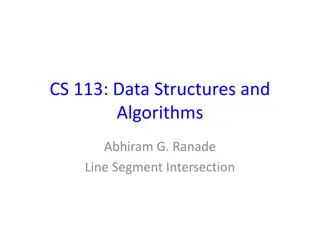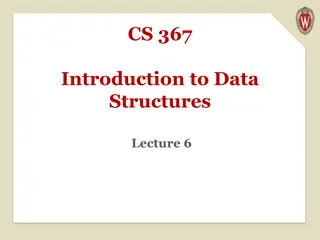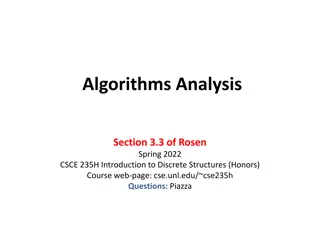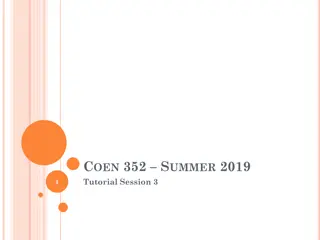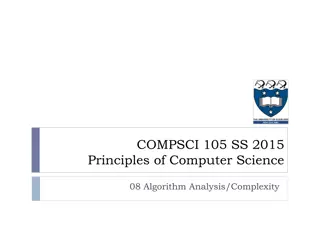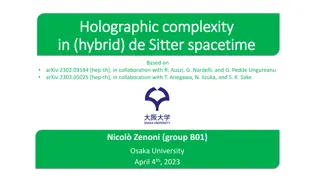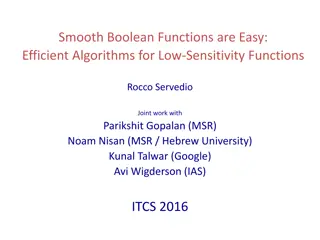Understanding Time Complexity in Algorithm Analysis
Explore the concept of time complexity in algorithm analysis, focusing on the efficiency of algorithms measured in terms of execution time and memory usage. Learn about different complexities such as constant time, linear, logarithmic, and exponential, as well as the importance of time complexity comparisons in algorithm evaluation. Discover the factors that do not affect time complexity analysis and the objectives of analyzing time complexity. Dive into discussions on the independence of time complexity analysis from programming language and machine used.
Download Presentation

Please find below an Image/Link to download the presentation.
The content on the website is provided AS IS for your information and personal use only. It may not be sold, licensed, or shared on other websites without obtaining consent from the author. Download presentation by click this link. If you encounter any issues during the download, it is possible that the publisher has removed the file from their server.
E N D
Presentation Transcript
Analysis of Algorithms CS 1037a Topic 13
Overview Time complexity - exact count of operations T(n) as a function of input size n - complexity analysis using O(...) bounds - constant time, linear, logarithmic, exponential, complexities Complexity analysis of basic data structures operations Linear and Binary Search algorithms and their analysis Basic Sorting algorithms and their analysis
Related materials from Main and Savitch Data Structures & other objects using C++ Sec. 12.1: Linear (serial) search, Binary search Sec. 13.1: Selection and Insertion Sort
Analysis of Algorithms Efficiency of an algorithm can be measured in terms of: Execution time (time complexity) The amount of memory required (space complexity) Which measure is more important? Answer often depends on the limitations of the technology available at time of analysis 13-4
Time Complexity For most of the algorithms associated with this course, time complexity comparisons are more interesting than space complexity comparisons Time complexity: A measure of the amount of time required to execute an algorithm 13-5
Time Complexity Factors that should not affect time complexity analysis: The programming language chosen to implement the algorithm The quality of the compiler The speed of the computer on which the algorithm is to be executed 13-6
Time Complexity Time complexity analysis for an algorithm is independent of programming language,machine used Objectives of time complexity analysis: To determine the feasibility of an algorithm by estimating an upper bound on the amount of work performed To compare different algorithms before deciding on which one to implement 13-7
Time Complexity Analysis is based on the amount of work done by the algorithm Time complexity expresses the relationship between the size of the input and the run time for the algorithm Usually expressed as a proportionality, rather than an exact function 13-8
Time Complexity To simplify analysis, we sometimes ignore work that takes a constant amount of time, independent of the problem input size When comparing two algorithms that perform the same task, we often just concentrate on the differences between algorithms 13-9
Time Complexity Simplified analysis can be based on: Number of arithmetic operations performed Number of comparisons made Number of times through a critical loop Number of array elements accessed etc 13-10
Example: Polynomial Evaluation Suppose that exponentiation is carried out using multiplications. Two ways to evaluate the polynomial p(x) = 4x4 + 7x3 2x2 + 3x1 + 6 are: Brute force method: p(x) = 4*x*x*x*x + 7*x*x*x 2*x*x + 3*x + 6 Horner s method: p(x) = (((4*x + 7) * x 2) * x + 3) * x + 6 13-11
Example: Polynomial Evaluation Method of analysis: Basic operations are multiplication, addition, and subtraction We ll only consider the number of multiplications, since the number of additions and subtractions are the same in each solution We ll examine the general form of a polynomial of degree n, and express our result in terms of n We ll look at the worst case (max number of multiplications) to get an upper bound on the work 13-12
Example: Polynomial Evaluation General form of polynomial is p(x) = anxn + an-1xn-1 + an-2xn-2+ + a1x1 + a0 where an is non-zero for all n >= 0 13-13
Example: Polynomial Evaluation Analysis for Brute Force Method: p(x) = an* x * x * * x * x + n multiplications a n-1* x * x * * x * x + n-1 multiplications a n-2* x * x * * x * x + n-2 multiplications + a2 * x * x + 2 multiplications a1 * x + 1 multiplication a0 13-14
Example: Polynomial Evaluation Number of multiplications needed in the worst case is T(n) = n + n-1 + n-2 + + 3 + 2 + 1 = n(n + 1)/2 (result from high school math **) = n2/2 + n/2 This is an exact formula for the maximum number of multiplications. In general though, analyses yield upper bounds rather than exact formulae. We say that the number of multiplications is on the order of n2, or O(n2). (Think of this as being proportional to n2.) (** We ll give a proof for this result a bit later) 13-15
Example: Polynomial Evaluation Analysis for Horner s Method: p(x) = ( ((( an * x + 1 multiplication an-1) * x + 1 multiplication an-2) * x + 1 multiplication + n times a2) * x + 1 multiplication a1) * x + 1 multiplication a0 T(n) = n, so the number of multiplications is O(n) 13-16
Example: Polynomial Evaluation n (Horner) 5 n2/2 + n/2 (brute force) 15 n2 25 10 55 100 20 210 400 100 5050 10000 1000 500500 1000000 13-17
Example: Polynomial Evaluation 600 500 f(n) = n2 T(n) = n2/2 + n/2 400 # of mult s 300 200 100 g(n) = n 5 10 15 n (degree of polynomial) 20 25 30 35 13-18
Sum of First n Natural Numbers Write down the terms of the sum in forward and reverse orders; there are n terms: T(n) = 1 + 2 + 3 + + (n-2) + (n-1) + n T(n) = n + (n-1) + (n-2) + + 3 + 2 + 1 Add the terms in the boxes to get: 2*T(n) = (n+1) + (n+1) + (n+1) + + (n+1) + (n+1) + (n+1) = n(n+1) Therefore, T(n) = (n*(n+1))/2 = n2/2 + n/2 13-19
Order-of-Magnitude Analysis and Big O Notation Figure 9-3a A comparison of growth-rate functions: (a) in tabular form 27
Order-of-Magnitude Analysis and Big O Notation Figure 9-3b A comparison of growth-rate functions: (b) in graphical form 28
Constant Time Complexity Algorithms whose solutions are independent of the size of the problem s inputs are said to have constant time complexity Constant time complexity is denoted as O(1) 13-33
Time Complexities for Data Structure Operations Many operations on the data structures we ve seen so far are clearly O(1): retrieving the size, testing emptiness, etc We can often recognize the time complexity of an operation that modifies the data structure without a formal proof 13-34
Time Complexities for Array Operations Array elements are stored contiguously in memory, so the time required to compute the memory address of an array element arr[k] is independent of the array s size: It s the start address of arr plus k * (size of an individual element) So, storing and retrieving array elements are O(1) operations 13-35
Time Complexities for Array-Based List Operations Assume an n-element List: insert operation is O(n) in the worst case, which is adding to the first location: all n elements in the array have to be shifted one place to the right before the new element can be added 13-36
Time Complexities for Array-Based List Operations Inserting into a full List is also O(n): replaceContainer copies array contents from the old array to a new one (O(n)) All other activies (allocating the new array, deleting the old one, etc) are O(1) Replacing the array and then inserting at the beginning requires O(n) + O(n) time, which is O(n) 13-37
Time Complexities for Array-Based List Operations remove operation is O(n) in the worst case, which is removing from the first location: n-1 array elements must be shifted one place left retrieve, replace, and swap operations are O(1): array indexing allows direct access to an array location, independent of the array size; no shifting occurs find is O(n) because the entire list has to be searched in the worst case 13-38
Time Complexities for Linked List Operations Singly linked list with n nodes: addHead, removeHead, and retrieveHead are all O(1) addTail and retrieveTail are O(1) provided that the implementation has a tail reference; otherwise, they re O(n) removeTail is O(n): need to traverse to the second-last node so that its reference can be reset to NULL 13-39
Time Complexities for Linked List Operations Singly linked list with n nodes (cont d): Operations to access an item by position (add , retrieve, remove(unsigned int k), replace) are O(n):need to traverse the whole list in the worst case Operations to access an item by its value (find, remove(Item item)) are O(n) for the same reason 13-40
Time Complexities for Linked List Operations Doubly-linked list with n nodes: Same as for singly-linked lists, except that all head and tail operations, including removeTail, are O(1) Ordered linked list with n nodes: Comparable operations to those found in the linked list class have the same time complexities add(Item item) operation is O(n): may have to traverse the whole list 13-41
Time Complexities for Stack Operations Stack using an underlying array: All operations are O(1), provided that the top of the stack is always at the highest index currently in use: no shifting required Stack using an array-based list: All operations O(1), provided that the tail of the list is the top of the stack Exception: push is O(n) if the array size has to double 13-42
Time Complexities for Stack Operations Stack using an underlying linked list: All operations are, or should be, O(1) Top of stack is the head of the linked list If a doubly-linked list with a tail pointer is used, the top of the stack can be the tail of the list 13-43
Time Complexities for Queue Operations Queue using an underlying array-based list: peek is O(1) enqueue is O(1) unless the array size has to be increased (in which case it s O(n)) dequeue is O(n) : all the remaining elements have to be shifted 13-44
Time Complexities for Queue Operations Queue using an underlying linked list: As long as we have both a head and a tail pointer in the linked list, all operations are O(1) important: enqueue() should use addTail() dequeue() should use removeHead() Why not the other way around? No need for the list to be doubly-linked 13-45
Time Complexities for Queue Operations Circular queue using an underlying array: All operations are O(1) If we revise the code so that the queue can be arbitrarily large, enqueue is O(n) on those occasions when the underlying array has to be replaced 13-46
Time Complexities for OrderedList Operations OrderedList with array-based m_container: Our implementation of insert(item)(see slide 10-12) uses linear search that traverses the list from its beginning until the right spot for the new item is found linear complexity O(n) Operation remove(int pos) is also O(n) since items have to be shifted in the array 13-47
Basic Search Algorithms and their Complexity Analysis 13-48
Linear Search: Example 1 The problem: Search an array a of size n to determine whether the array contains the value key; return index if found, -1 if not found Set k to 0. While (k < n) and (a[k] is not key) Add 1 to k. If k == n Return 1. Return k. 13-49
Analysis of Linear Search Total amount of work done: Before loop: a constant amount a Each time through loop: 2 comparisons, an and operation, and an addition: a constant amount of work b After loop: a constant amount c In worst case, we examine all n array locations, so T(n) = a +b*n + c = b*n + d, where d = a+c, and time complexity is O(n) 13-50
Analysis of Linear Search Simpler (less formal) analysis: Note that work done before and after loop is independent of n, and work done during a single execution of loop is independent of n In worst case, loop will be executed n times, so amount of work done is proportional to n, and algorithm is O(n) 13-51
Analysis of Linear Search Average case for a successful search: Probability of key being found at index k is 1 in n for each value of k Add up the amount of work done in each case, and divide by total number of cases: ((a*1+d) + (a*2+d) + (a*3+d) + + (a*n+d))/n = (n*d + a*(1+2+3+ +n))/n = n*d/n + a*(n*(n+1)/2)/n = d + a*n/2 + a/2 = (a/2)*n + e, where constant e=d+a/2, so expected case is also O(n) 13-52
Analysis of Linear Search Simpler approach to expected case: Add up the number of times the loop is executed in each of the n cases, and divide by the number of cases n (1+2+3+ +(n-1)+n)/n = (n*(n+1)/2)/n = n/2 + 1/2; algorithm is therefore O(n) 13-53
Linear Search for LinkedList Linear search can be also done for LinkedList exercise: write code for function template <class Item> template <class Equality> int LinkedList<Item>::find(Item key) const { } Complexity of function find(key) for class LinkedList should also be O(n) 13-54
Binary Search (on sorted arrays) General case: search a sorted array a of size n looking for the value key Divide and conquer approach: Compute the middle index mid of the array If key is found at mid, we re done Otherwise repeat the approach on the half of the array that might still contain key etc 13-55
Example: Binary Search For Ordered List int binarySearch(m_container, key) { int first = 1, last = m_container.getLength(); while (first <= last) { // start of while loop int mid = (first+last)/2; Item val = retrieve(mid); if (key < val) last = mid-1; else if (key > val) first = mid+1; else return mid; } // end of while loop return 1; } 13-56
Analysis of Binary Search The amount of work done before and after the loop is a constant, and independent of n The amount of work done during a single execution of the loop is constant Time complexity will therefore be proportional to number of times the loop is executed, so that s what we ll analyze 13-57
Analysis of Binary Search Worst case: key is not found in the array Each time through the loop, at least half of the remaining locations are rejected: After first time through, <= n/2 remain After second time through, <= n/4 remain After third time through, <= n/8 remain After kth time through, <= n/2k remain 13-58
Analysis of Binary Search Suppose in the worst case that maximum number of times through the loop is k; we must express k in terms of n Exit the do..while loop when number of remaining possible locations is less than 1 (that is, when first > last): this means that n/2k < 1 13-59
Analysis of Binary Search Also, n/2k-1 >=1; otherwise, looping would have stopped after k-1 iterations Combining the two inequalities, we get: n/2k < 1 <= n/2 k-1 Invert and multiply through by n to get: 2k > n >= 2 k-1 13-60
Analysis of Binary Search Next, take base-2 logarithms to get: k > log2(n) >= k-1 Which is equivalent to: log2(n) < k <= log2(n) + 1 Thus, binary search algorithm is O(log2(n)) in terms of the number of array locations examined 13-61









